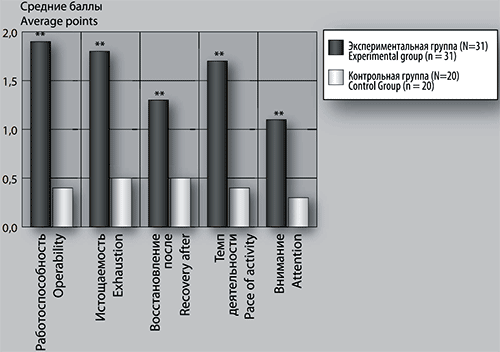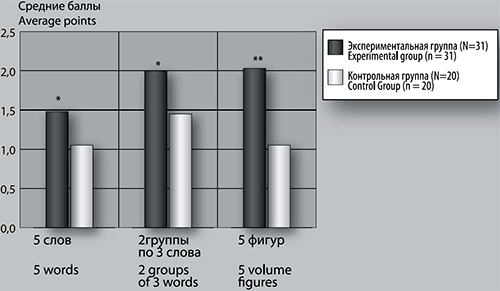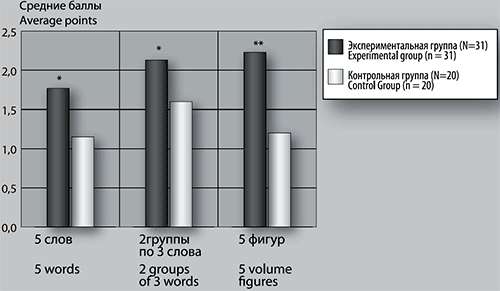Disturbances of higher mental functions in adolescents after mild traumatic
Recieved: 11/03/2019
Accepted: 12/12/2019
Published: 12/31/2019
Pages: 102-113
DOI: 10.11621/npj.2019.0410
Keywords: developmental neuropsychology; traumatic brain injury; adolescent age; neuropsychological syndrome; higher mental functions (APF); cognitive functions
Available online: 31.12.2019
Gorina Irina S. (1961-2016), Goryacheva Tatiana G., Kovtoniuk Svetlana V. (2019). Disturbances of higher mental functions in adolescents after mild traumatic. National Psychological Journal, (4) , 102-113. https://doi.org/10.11621/npj.2019.0410
Copied to Clipboard
CopyAbstract
Background. The influence of mild traumatic brain injury (MTBI) on mental functions is not given a proper account in modern neurology and neuropsychology. The data published provide information on the state of higher mental functions (HMF) and on disturbances of the psychological well-being of children and adolescents after MTBI. The analysis of research materials in this area provides data on disorders associated with both local and cerebral symptoms, which form a diverse picture of cognitive and behavioural disorders.
The Objective is to study HMF in adolescents of 10-14 years old after TBI of mild severity as part of the methodology of neuropsychological syndrome analysis (Luria, 1973). Design. The study is based on the original set of techniques designed by A.R. Luria. We focused on assessing the status of various HMF components (motor areas, gnostic areas of memory and intelligence). We also studied the mental activity in its regulatory and dynamic aspects. The population included 31 patients with MTBI and 20 healthy subjects.
Results. The analysis of the results showed that violations of HMF in the acute period were represented by three types of syndromes. The leading place in each syndrome is occupied by deficiency symptoms of non-specific brain structures.
Conclusion. The information obtained enriches the knowledge of neuropsychology about the patterns of development of brain systems and related mental functions in adolescence, and also allows one to choose more suitable options for rehabilitation effects aimed at improving the adaptation of patients, enhancing their quality of life, and preventing negative consequences of MTBI.
Table 1. Values of "average time of task completion" parameter ("Schulte table")
|
Group |
Timing |
|||
|
35-45 sec |
45-60 sec |
60-75 sec |
75-90 sec |
|
|
Adolescents with MTBI |
29% ** |
45.2% ** |
16.1% |
9.7% |
|
Healthy Adolescents |
70% |
30% |
- |
- |
NB ** The differences are valid when comparing adolescents with MTBI and healthy adolescents: (p≤0.001).
Table 2. Values of the parameter "average number of digits found in 10 seconds" ("Schulte table")
|
Number of digits |
Group |
|
|
3-5 digits |
6-8 digits |
|
|
Adolescents with MTBI |
77.4% * |
22.6% * |
|
Healthy Adolescents |
50% |
50% |
NB ** The differences are valid when comparing adolescents with MTBI and healthy.

Fig. 1. Background characteristics comparison in the experimental and control groups
Note. ** The differences are significant when comparing adolescents with MTBI and healthy adolescents: (p≤0.001).

Fig 2. Mnestic function comparison in the experimental and control groups by the “memory size” parameter
NB The differences are valid when comparing adolescents with MTBI and healthy adolescents: * (p≤0.05); ** (p≤0.001).

Fig 3. Mnestic function comparison in the experimental and control groups by the “reproduction” parameter
NB The differences are valid when comparing adolescents with MTBI and healthy adolescents: * (p≤0.05); ** (p≤0.001).
References:
Berkowitz С. (2014). Berkowitz’s Pediatrics: A Primary Care Approach, 5th Edition. American Academy of Pediatrics, 950.
Boldyreva G.N., & Manelis N.G. (1998). Response of the human brain to damage to the limbic structures. In Eds. E.D. Khomskaya, & T.V.Akhutina, [1 Mezhdunarodnaya konferentsiya pamyati A.R.Luriya]. Moscow, MGU-RPO, 118–126.
Bragin N.N., & Dobrokhotova T.A. (1988). Functional asymmetries of human. Moscow, Meditsina, 240.
Buklina S.B. (2012). Disturbances of higher mental functions after injuries in different parts of the brain stem. [Nasledie A.R.Lurii v sovremennom nauchnom i kul'turno-istoricheskom kontekste], 129–147.
Carli P, & Orliaguet G. (2004). Severe traumatic brain injury in children. Lancet, 363(9409), 584–585. doi: 10.1016/S0140-6736(04)15626-2
Cassidy, J. D., Carroll, L., Peloso, P., Borg, J., Von Holst, H., Holm, L., & Coronado, V. (2004). Incidence, risk factors and prevention of mild traumatic brain injury: Results of the WHO Collaborating Centre Task Force on Mild Traumatic Brain Injury. Journal of Rehabilitation Medicine, 36, 28–60. doi: 10.1080/16501960410023732
Collins C, & Dean J (2002). "Acquired brain injury". In Turner A, Foster M, Johnson SE. Occupational Therapy and Physical Dysfunction: Principles, Skills and Practice. Edinburgh: Churchill Livingstone, 395–96.
Dobrokhotova T.A., & Zaitsev O.S. (1999). Mental disorders in traumatic brain injury. In A. S. Tiganova (Ed.). [Rukovodstvo po psikhiatrii], In 2 vols. Moscow, Meditsina, Vol. 2, 156194.
Glozman, Zh.M. (2012). Neuropsychological examination: a qualitative and quantitative assessment of the data Mosocw, Smysl, 264.
Gogitidze N.V. (1990). Dynamics of neuropsychological syndromes under the influence of neurotropic drugs in patients with traumatic brain injury: Ph.D. in Medicine, thesis. Moscow.
Gorina I.S. & Kosterina M.Yu. (1996). The study of neuropsychological syndromes in individuals who participated in LPA at the Chernobyl NPP. [Psikhologiya segodnya Ezhegodnik RPO], Vol. 2, Moscow.
Grebennikova N.V. (1985). The dynamics of the restoration of higher mental functions with a closed brain injury of the frontal lobes: Ph.D. in Medicine, Thesis, Moscow.
Hardman J.M, & Manoukian A (2002). Pathology of head trauma. Neuroimaging Clinics of North America, 12 (2), 175–87, "TBI is highest in young adults aged 15 to 24 years and higher in men than women in all age groups". doi: 10.1016/S1052-5149(02)00009-6
Kamenskaya V.M., Bragina N.N., Dobrokhotova T.A., & Chebysheva L.N. (1976). Functional asymmetry and human adaptation. Moscow.
Khomskaya E.D. (2005). Neuropsychology. St. Petersburg, Piter, 496.
Korsakova N.K., & Moskovichute L.I. (1985). Subcortical brain structures and mental processes. Moscow, Izdatel’stvo MGU.
Korsakova N.K., Mikadze Yu.V., & Balashova E.Yu. (2017). Unsuccessful children: neuropsychological diagnosis of elementary schoolchildren: a textbook for undergraduate and graduate studies. Moscow, Yurayt.
Korsakova N.K., & Moskovichute L.I. (2018) Clinical Neuropsychology. Moscow, Yurait.
Likhterman L.B., Kravchuk A.D., & Filatova M.M. (2008). Concussion: treatment tactics and outcomes. Moscow, 157.
Luria A.R. (1973). Fundamentals of Neuropsychology. Izdatel’stvo Moskovskogo Universiteta.
Manelis N.G. (1999). Neuropsychological patterns of normal development. [Shkola zdorov’ya], 1, 8–25.
Max J.E., Schachar R.J., Levin H.S., Ewing-Cobbs L., Chapman S.B., Dennis M., Saunders A., & Landis J. (2005). Predictors of attention-deficit/hyperactivity disorder within 6 months after pediatric traumatic brain injury. J Am Acad Child Adolesc Psychiatry, 44, 1032–1040. doi: 10.1097/01.chi.0000173293.05817.b1
McCrea, M., Hammeke, T., Olsen, G., Leo, P., & Guskiewicz, K. (2004). Unreported concussion in high school football players: implications for prevention. Clinical Journal of Sport Medicine, 14(1), 13–17. doi: 10.1097/00042752-200401000-00003
McCrory P., & McCrory, P. (2013). Traumatic brain injury: revisiting the AAN guidelines on sport-related concussion. Nature Reviews. Neurology, 9(7), 361–362. PubMed. doi: 10.1038/nrneurol.2013.88
McCrory, P., Johnston, K., Meeuwisse, W., Aubry, M., Cantu, R., Dvorak, J., & Schamasch, P. (2005). Summary and agreement statement of the 2nd International Conference on Concussion in Sport, Prague 2004. British Journal of Sports Medicine, 39(4), 196–204. doi: 10.1097/01.jsm.0000159931.77191.29
Mikadze Yu.V. (2012). Neuropsychology of childhood. St. Petersburg, Piter.
Moskovichyute L.I. (1998). Asymmetry of the cerebral hemispheres at the level of the cortex and subcortical formations. In Eds. E.D. Khomskaya, & T.V.Akhutina, [1 Mezhdunarodnaya konferentsiya pamyati A.R.Luriya]. Moscow, 96–101.
Nemkova S.A., Zavadenko N.N., Maslova O.I., & Karkashadze G.A. (2014). Diagnosis and correction of cognitive impairment in children with the consequences of traumatic brain injury. [Pediatricheskya Farmakologiya], 11(3), 54–61. doi: 10.15690/pf.v11i3.1009
Nemkova S.A., Zavadenko N.N., & Nesterovsky Yu.V. (2015). Cognitive impairment in children with consequences of traumatic brain injury. [Practicheskaya Pediatriya], 10(3), 58–67. doi: 10.15690/pf.v11i3.1009
Nepomnyashchy V.P., Likhterman L.B., & Yartsev V.V. (1998). Epidemiology of traumatic brain injury and its consequences. In Eds. A.N. Konovalova, L.B. Likhterman, & A.A. Potapova. [Klinicheskoe rukovodstvo po cherepno-mozgovoy travme]. Moscow, Antidor, 129–151.
Saatman K.E., Duhaime A.C., Bullock R., Maas A.I., Valadka A., & Manley G.T. (2008). Classification of traumatic brain injury for targeted therapies, 25(7), 719–38. doi: 10.1089/neu.2008.0586.
Schachar R., Levin H.S., Max J.E., Purvis K., & Chen S. (2004). Attention deficit hyperactivity disorder symptoms and response inhibition after closed head injury in children: do preinjury behavior and injury severity predict outcome? Dev Neuropsychol., 25, 179–98. doi: 10.1207/s15326942dn2501&2_10
Sesma H.W., Slomine B.S., Ding R., & McCarthy M.L. (2008). Executive functioning in the first year after pediatric traumatic brain injury. Pediatrics, 121, 1686–1695. doi: 10.1542/peds.2007-2461
Wilkinson A.A., Dennis M., Simic N., Taylor M.J., Morgan B.R., Frndova H., Choong K., Campbell C., Fraser D., Anderson V., Guerguerian A.M., Schachar R., & Hutchison J. (2017). Brain biomarkers and pre-injury cognition are associated with long-term cognitive outcome in children with traumatic brain injury. BMC Pediatr., 17(1), 173–178. doi: 10.1186/s12887-017-0925-6
Williamson DJ.G, Scott J.G., & Adams R.I. (1996). Traumatic brain injury. In Adams RL, Parsons O.A., Culbertson J.L., Nixon S.J., Eds. Neuropsychology for clinical practice. Etiology, assessments and treatment of common neurological disorders. Washington, D.C.: American Psychological Association, 9–64. doi: 0.1037/10198-001
Yakhno, N.N. & Shtulman D.R. (2001). Diseases of the nervous system. A guide for doctors in 2 volumes.
Zavadenko N.N., & Guzilova L.S. (2012). Consequences of closed traumatic brain injury in adolescents: the role of magnesium deficiency and the possibility of its therapeutic correction. [Pediatriya. Zhurnal im. G.N.Speranskogo], 91(1), 81–88.
Gorina Irina S. (1961-2016), Goryacheva Tatiana G., Kovtoniuk Svetlana V.. Disturbances of higher mental functions in adolescents after mild traumatic. // National Psychological Journal 2019. 4. Pages102-113. doi: 10.11621/npj.2019.0410
Copied to Clipboard
Copy

